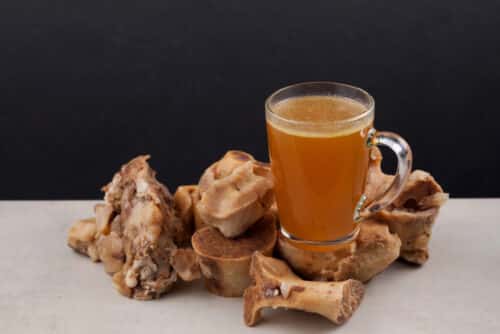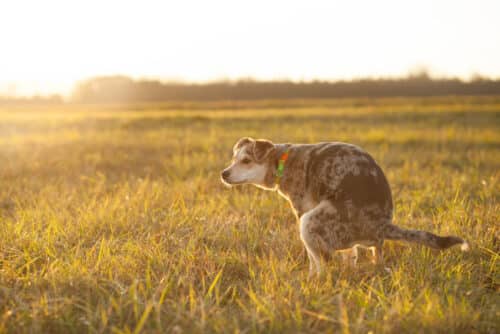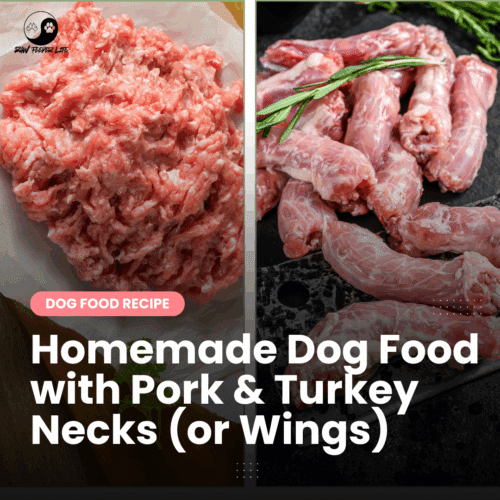Keep the Tail Wagging is supported by pet parents. I occasionally earn a commission (at no additional cost to you) when you click through an affiliate link to one of my favorite products. Thank you for your support. Read More
What are Fermented Vegetables?
Vegetables become fermented when the sugars in the vegetables are converted into acids by beneficial bacteria. This process is typically carried out in an environment without oxygen (sealed, wide-mouth jars).
To make fermented vegetables, fresh vegetables are submerged in a brine solution or packed tightly in a container with salt, allowing for the growth of beneficial microorganisms. These microorganisms, such as lactobacilli bacteria, initiate the fermentation process by consuming the sugars in the vegetables and converting them into lactic acid. This acidification creates a sour or tangy taste and preserves the vegetables.
My fermented vegetable blends commonly include cabbage, carrots, zucchini, squash, peppers, and garlic.
Fermented vegetables are known for their distinct flavors, textures, and health benefits. I enjoy the flavors and often eat sauerkraut and kimchi, but not all dogs are fans of the tangy taste.
Benefits of Fermented Vegetables for Dogs
I began fermenting vegetables to support my dog's gut health, but there are many more benefits.
Improved Digestion
Fermentation breaks down complex carbohydrates and proteins in vegetables, making them more digestible. This is especially beneficial for dogs that don't produce amylase (the enzyme that digests carbs/vegetables) in their saliva. This can be especially beneficial for dogs with digestive issues.
Improved Gut Health
Fermented vegetables are rich in beneficial bacteria (or probiotics), which support a healthy gut microbiome and robust immune system.
Increased Nutrient Bioavailability
The fermentation process enhances the bioavailability of certain nutrients, making them more easily absorbed by the body. This includes vitamins, minerals, and antioxidants in vegetables, such as vitamins C, K, and folate.
Anti-Inflammatory/Anti-Cancer
Fermentation can increase the production of specific antioxidants and phytochemicals, which have anti-inflammatory and anticancer effects.
Potential Weight Management Benefits
Some studies suggest that consuming fermented foods may improve weight management. The gut microbiota plays a role in regulating metabolism, and a healthy balance of bacteria may support healthy weight control.
Recipe for Fermented Vegetables for Dogs
I learned how to ferment vegetables from a recipe shared by the Canine Ascension Facebook page.
The below recipe produced eight jars of fermented vegetables. I don't add vegetables to my dogs' diet daily so this recipe will last a while with my four dogs.
Ingredients
This is my preferred recipe; the ingredients listed aren't all required. You can start with two heads of cabbage and a tablespoon of sea salt.
- 1 green cabbage
- 1 red cabbage
- 5 small zucchini and yellow squash
- 3-4 carrots
- 1 garlic bulb (yes, this is safe for dogs, but not necessary)
- 2-1/2 tbsp of sea salt (don't use table salt)
- water (as needed)
Equipment for Fermenting
- Easy Fermenter Set (Lids and Pump)
- Easy Fermenter Weights
- Packer (optional)
- Ball Wide Mouth Mason Jars
- Stainless Steel Bowls
Making Fermented Vegetables for Dogs
- Peel the top layer of leaves from the cabbages and set them aside for use later.
- Chop up all the vegetables as finely as possible; the list of vegetables above will fill two 8-quart stainless steel bowls. If you only use two heads of cabbage, you'll fill one 8-quart stainless steel bowl.
- Add 1-1/4 tbsp of freshly ground sea salt to each bowl and massage the vegetables until they become wet (add 1 tbsp if there are only two heads of cabbage). The salt helps to draw water out of the vegetables, which will be the brine to allow fermentation. The salt also serves as food for the bacteria (minimal salt remains when the fermentation is complete).
- Allow the bowls to sit for 20 minutes, then massage the vegetables again. You'll notice that the vegetables seem to be shrinking, and liquid (this is your brine) begins to collect at the bottom of the bowl. I started with a bowl overflowing with vegetables, and after massaging twice, there were 3 inches of room at the top of each bowl.
- Repeat the message/sit for one or two more times; if there isn't a good amount of liquid (the brine) in the bottom of the bowl (see video below), then add a small amount of water.
- Spoon the vegetables into each jar, using a large, flexible spoon to press the vegetables down. This removes any air pockets and makes room for more vegetables. You can also purchase a packer (see list above) to help with this step.
- When the vegetables are evenly distributed and packed down tight, add the cabbage leaves (pack down again) and add one weight per jar. Seal each jar with the Easy Fermenter lids (see list above).
- Ferment vegetables for 20 days (10 days in the summer); the Easy Fermenter lids allow you to dial to the date when the fermentation is complete. I use the pump in the kit to remove any excess air each week until the vegetables are ready; this is optional.
Isn't Salt Bad for Dogs?
The salt used to ferment vegetables helps to bring the liquid out of the vegetables and serves as food for the growing bacteria that ferments the vegetables. When the vegetables are ready, they taste amazing – you won't be able to taste the salt. This small amount of salt isn't bad for dogs or humans; excess salt is something we want to avoid.
How Do I Know When the Fermentation is Done?
The beauty of the Easy Fermenter system is that it's super easy. Dialing to the date that the ferment is done is when the ferment is done.
- 20 days during cooler months
- 10 days during hotter months
Fermenting is a continual process; it doesn't just stop unless you put it in the refrigerator or freezer. I've forgotten about my vegetables or gotten the date wrong and pulled them two days after their completion date many times, and they were just fine. But this isn't foolproof.
Read: FermentedFoodLab.com for a list of frequently asked questions and answers.
If I don't seal the jar properly, the longer the ferment period, the more mold growth will occur, ruining the ferment. So, I must also know when my ferment is done by sight.
Bubbles in the Jars – I first noticed the bubbling around the vegetables in the jars. That tells me the ferment is ready (or very close) for me to transfer to freezer-safe containers.
A Sour Fermenty Smell – when I open the jars, a sour odor should come out, not a vegetable odor. What do I mean by “fermenty?” It's difficult to explain, but you'll recognize the smell of fermented vegetables after a while. This is why I don't ferment spinach or kale – the smell SUCKS!
Give the Ferment a Taste – and, finally, you can also do a taste test to see if it tastes like fermented vegetables. I only taste the vegetables when I ferment cabbage and carrots – a yummy blend I don't mind sharing with my dogs.
Will My Dogs Eat Fermented Vegetables?
I can't promise that your dogs will eat fermented vegetables. Hence, I recommend creating a small batch or buying fermented vegetables at a natural grocery store if you're uncertain. Bubbies and Firefly Kitchens are great brands; I suggest choosing ferments that don't contain onions.
Or you can make a test batch and see how they like them.
Feeding Guidelines for Fermented Vegetables
I use a base mix containing dehydrated vegetables in the formulation I created for my dogs; therefore, I don't add many fermented vegetables to their meals. When I feed fermented vegetables, I often add one tablespoon (usually a heaping spoonful) to their meals once daily.
If your dog is new to eating fermented vegetables, start small and work your way up to allow their gut to get used to this unique treat. And if your dog isn't a fan of fermented vegetables, no worries; there are other fermented options: raw goat's milk, kefir, and fermented fish bone broth/stock.
CLICK HERE for a recipe for fermenting seeds for dogs.
Can I Freeze Fermented Vegetables?
Once the ferment is complete, I move a couple of jars to the fridge and the rest to a cold area (garage or cellar). The cold temperatures slow the fermentation. I've read that fermented vegetables can be stored for up to a year; however, my concern is that the probiotics won't remain viable for twelve months, so I only freeze them for a month. Once opened, I keep them in the fridge for up to two weeks.
Read: Fermenting Veggies FAQs by FermentedFoodLab.com for answers to more questions.
Histamines in Fermented Foods
I've been told not to feed fermented foods to dogs with allergies due to the histamines; however, others have said there aren't enough histamines in fermented foods to trigger a dog's allergies. To be safe, I would either avoid fermented foods or go easy when adding them to my dog's diet.
Alternatives to DIY Fermenting for Dogs
If fermenting isn't for you, that's okay. There are some amazing products on the market for dogs. I purchase the following for my dogs:
- Gussy's Gut is a blend of organic, fermented, freeze-dried vegetables that promote a robust immune system and healthy gut microbiome. One bag will last over two months for three large dogs; I split a tablespoon between my dogs in their evening meals five days weekly. I highly recommend Gussy's Gut, as I've seen the benefits in my dogs, including healing one dog's leaky gut.
The following products can be found at your local independent pet store:
- Green Juju Bam's Beets – A whole food source of probiotics, antioxidants, vitamins, minerals, and enzymes made from fermented organic red beets and purple cabbage. A great way to begin adding fermented foods to the bowl.
- Green Juju Lua's Golden Paste (highly recommended) – Organic turmeric and coconut oil fermented as a whole food source of anti-inflammatory plant compounds – the most effective way for the body to utilize turmeric.
Learn More About Fermenting Vegetables for Dogs
Because I'm simply sharing what I'm doing for my dogs, you may find it helpful to read up on fermenting vegetables from the various sources I found online.
- Fermenting Veggies FAQs, FermentedFoodLab.com
- Fermented Foods for Dogs and Cats – Dr. Heartway
- Fermented Foods for Dogs – Animal Wellness Magazine
- Fermented Veggies for Your Dog – Canine Ascension
- Fermented Pumpkin Seeds for Your Dog – Canine Ascension
- 5 Advantages and Disadvantages of Fermented Foods – ConnectUsFund.org







You are SUCH a wealth of knowledge, Kimberly. I ALMOST want to give in to the anti-privacy czar (Facebook) and sign up just to join your raw feeding group!
I have been making my own kefir from raw goat milk and raw cow milk (both from local and ethical dairies) and usually feed the boys all the whey along with the kefir, but now I think I will use the kefir for the seed ferments.
I have still been buying fermented veggies because I am still scared of making my own. I just dont want to screw it up and let it ferment too long or not long enough. Would it be reasonable to assume a person ferment is fine as long as there is no mold?
Again, I think you are a fountain of knowledge (and entertaining personality as well) and I very much enjoy coming here.
Thank you.
Hi Kathleen…
That’s a question for a more experienced fermenter. I use the Easy Fermenter set. I don’t have to cover the veggies with water, I use a weight to keep them tight, and I tighten up the lid immediately.
There are some great YouTube videos that go over fermenting. You may find your answer there.
Kimberly, So if i use the mason jars and lids am i correct in making sure its all covered in liquid with an inch of room at top then putting lids on loose for a few day before tightening them down ? If so when can i tighten them down and store in cool place safely without having to worry about leaking. Thank you
Thanks for the heads up. I’ll make change to my website to reflect this change.
Tried to order the inClover Optagest but the discount code (KTTW10) has expired…fyi.
Yep. I change up the vegetables I ferment all the time; as long as it’s safe for my dogs to eat.
My dogs are use to eating broccoli, cauliflower, spinach, kale, green and red cabbage right now, just not fermented. Can I ferment this or is your veggy recipe specific for dogs.
I put the brine in the jars. That’s the food for the bacteria. 🙂
Should I be putting the brine INTO the mason jars with the veggies, or draining them with a slotted spoon before I jar them up to ferment? Thank you!
Hi… for more information about feeding cats, check out these sites:
http://www.twocrazycatladies.com
http://pawesomecats.com
http://catcentric.org
There is any recipe, especially for cats. I am looking to feed my cat some homemade tasty food. Should i try this for my cat?
Why do you use crocks? Do you mean slow cookers? Does it make the fermenting go faster?
Hi Kimberly,
I am in Ontario Canada I have started a business called The Pickled Hound making lacto-fermented vegetables. I really like your article and I have been feeding my dogs fermented veggies for several months now. They were my test subjects on the veggies! They love them. I had mine lab tested and in a 500ml sample there was 30000000 CFU/g of lactobicillus. Fermented veggies are far superior to commerically produced probiotics, cheaper to make and are loaded with Vitamins, B-Vitamins and minerals. I use 4- 10L crocks and will be upgrading to 20L crocks soon to keep up with demand.
I rotate through Franks saurkraut… tbs for him tbs for me. It lasts about a week and then I take a break back to carna4. His stomach does not do well on my veggie mix. 🙁 I can always count on loosy goosy if I feed him pulverized veggies. He will eat squash and cucumbers just on their own and does fine. Just not pureed.
This is super helpful and as usual something I should be doing for my own heath as well, but I’m much more motivated by my dog’s health!
I’m trying hard to reduce my 7 month old Boxer’s urine PH as it’s an unhealthy 9. Do you think this might help? I’ll check with my vet as well, but I think perhaps this isn’t in her arsenal of good nutrition info yet.
Thanks!